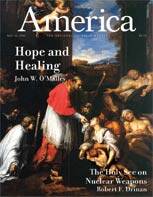"After viewing a city full of funerals, we return to our homes only to find them empty of our loved ones.” That’s what Petrarch wrote about the Black Death (bubonic plague), which in 1348 devastated Western Europe, killing an estimated two-thirds or more of the population. Europe recovered but only to continue to experience wave after wave of the plague well into the 18th century. Some of these later outbreaks took more lives in certain localities than had been lost there in 1348. In 1656-57 Genoa and Naples lost an estimated three-fifths of their population. In 1575, 1630 and 1720-22 there were similarly ferocious outbreaks, while smaller but still horrific epidemics occurred in almost every decade. When not actually battling a plague, Europeans lived in dread of its all-too-certain return. It was an abiding scourge.
This gruesome reality forms the background for a wonderful exhibition at the Worcester Museum of Art, Worcester, Mass., “Hope and Healing: Painting in Italy in a Time of Plague, 1500-1800.” Don’t be put off. This is not a morbid show. On the contrary, the exhibition makes clear that in the context of Christian faith, beauty can come forth out of horror and dread. It demonstrates the power of images to lift our spirits. Images, the most material of the modes of human communication, point mutely to something beyond the power of words and concepts. Through oil, canvas and the skill of the artist’s hand, we are put in touch with something that is, literally, ineffable. We are thus potentially in the realm of religious discourse.
That at least was my experience of “Hope and Healing.” And it was the conviction of the persons who originally commissioned these works of art, for whom they were reminders that we are in God’s hands, that we have friends in the saints and that beyond death and suffering awaits resurrection. “Hope and Healing” is not about the “temporal remedies” for the plague, like quarantine, but about the “spiritual remedies,” as contemporaries designated them. It is about plague-saints, like Mary and Michael, like Rosalie and Aloysius Gonzaga. It is about Christ being laid in the tomb and about Christ rising from the dead. It is about tending to the needs of fellow human beings even at the risk of one’s own life, a Christian reality depicted time and again in the images from the 17th century of St. Charles Borromeo ministering to the sick and dying.
This is a moderate-sized exhibition of 37 pieces that include one engraving and a rare example of a ceremonial banner. The quality is high and the pieces beautifully installed. There are two paintings each by Van Dyck, Crespi, Tiepolo, Strozzi, Sweerts and Solimena and single paintings by Canaletto, Tintoretto and others. At first sight many of the paintings seem to have nothing to do with the plague. Decorum would not tolerate the depiction of scenes too gruesome.
But the painters left clues. The buboes, or swellings, could not be depicted, but the gesture of exposing the underarm region, where the buboes often appeared, was understood to indicate the plague. Another clue was a darkened body, whose discoloration was seen by contemporaries as a typical sign of the disease. One of the achievements of the exhibition is to alert us to such clues. The inference is that the number of plague-related paintings is far vaster than we ever realized.
“Hope and Healing” is sponsored by three Worcester institutions: the Museum, Clark University and the College of the Holy Cross. The idea for it came from a team of four curators: Franco Mormando of Boston College, Pamela Jones of the University of Massachusetts, Gauvin Alexander Bailey of Clark and Thomas Worcester, S.J., of Holy Cross. They masterminded the project from beginning to end, producing the first major exhibition about the plague ever held outside Italy. They also edited a superb catalogue, published by the University of Chicago Press, that in its seven articles tells us as much about the lived experience of Catholicism in early modern Europe as it does about art. There is no other book-length treatment of this important subject—the relationship between art and religion in the face of devastation.
So what? In the catalogue Franco Mormando makes clear that, though we live in an era of wonder drugs, we are still today threatened by forms of deadly contagious disease and by new “plagues”—AIDS, Ebola, SARS and others. After 9/11 came the terrifying prospect of terrorist-disseminated plagues, like anthrax and smallpox. These factors sparked the interest of the curators in “plague art” and led them to mount an exhibition about it.
It is helpful—and, for the most part, inspiring—to see aspects of how another society at another time reacted to a death-dealing onslaught that appeared time and again without warning and could wipe out entire families overnight. Religion offered hope and solace. It unfortunately also brought shame and guilt, as preachers exploited the tragedies and pronounced them punishments from God for sin.
The exhibition is about the help and consolation that religion can offer, but it is also a cautionary tale about the abuses of religion and the need to be tentative when speaking about the will of God. Besides the aesthetic pleasure the exhibition offers, therefore, it offers much food for thought.
If you can make it to Worcester before September 25, which is when the exhibition closes, I think you will be gratified by what you find there. If you cannot, you might want to visit vicariously through the catalogue with its excellent color reproductions of all the paintings.








